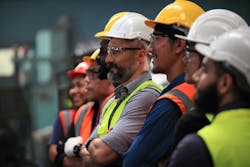Turning tacit knowledge into applied knowledge: How companies can maintain knowledge held by employees
In every industry, each employee possesses and uses knowledge to perform their job efficiently and to specific standards. The Oxford English Dictionary defines knowledge as “facts, information, and skills acquired by a person through experience or education.” This is a fitting definition but still encompasses a lot of variability, as everyone has different experiences and education. While companies cannot fully control the experience of their employees, education through a training program can help to level the playing field. Such training normally focuses on explicit knowledge through written documents, such as standard operating procedures, equipment manuals, etc. However, another side of knowledge is often bypassed: tacit knowledge. Tacit knowledge is the knowledge an employee gains from experiences, skill, and ideas, which are often underappreciated assets. In many industries, tacit knowledge is sometimes referred to as institutional or legacy knowledge.
What is tacit knowledge?
Tacit knowledge exists in all positions across the workforce; however, some positions rely more on tacit knowledge than others for success. In such positions, when someone or a group of people leave, the knowledge to successfully perform a job requirement may leave with them. The tacit knowledge they would take with them is the set of unwritten information known by the individuals but is not documented, and therefore generally unreachable by others within an organization. Some companies can even make the case that the knowledge imparted is actually intellectual property owned by the company, which can make the capturing of the tacit knowledge that much more important.
Some readers may feel that tacit knowledge is not a factor in their work, but everyone uses tacit knowledge in some form in their jobs. Consider the following scenarios:
- Doing something on the job that worked or made the job easier, so you repeat it over and over;
- Equipment or computer system recovery after a power outage;
- Short cuts or small deviations from a job function as trained that had no apparent ill effects and possibly improved results;
- Unlocking a door that requires jiggling the key or lifting the handle as the key is turned;
- Employee-created system passwords;
- Dealing with equipment that consistently breaks down (even if it is just a coffee machine in the break room).
In the bulk solids industry, there are a number of specific and common instances of tacit knowledge that many people may not realize. For example, the pneumatic unloading of railcars or PD trucks can get dialed in by the operators based on the material being unloaded. Employees will also partially cover the air intake on a vacuum system to get more suction and make a material transfer faster.
A humorous example is the parable of the experienced engineer, who retires and then is hired by his old manager as an independent consultant when the ‘Big Machine’ breaks down a few weeks later and no one at the company can get it to work properly again. The engineer walks into the plant, takes a look at the Big Machine, grabs a hammer, whacks the machine once, and the machine starts right up.
When the engineer sends the manager a bill for $5,000, the manager complains that the price is too high and demands that the engineer itemize the bill. The engineer complies and sends the following:
Hammer: $5
Knowing where to hit the machine with hammer: $4,995
Where does tacit knowledge come from?
Tacit knowledge has many potential sources, some due to conscious choices and others just due to repetition or observation. Some tacit knowledge is developed by people being inherently lazy. The often-quoted concept that you should hire a lazy person to do a hard job because a lazy person will find an easy way to do it applies here, and it is easy to see how this sentiment can lead to the creation of tacit knowledge.
Unintentional tacit knowledge can be generated as the mere byproduct of an employee doing their work over time and seeing small incremental improvements. Sometimes there are unexpected results from a process change (intentional or unintentional) that may not be documented but that employees remember. As people have different experiences on different shifts, results may vary, which can also be a large part of statistical process control efforts for a process engineer.
Finally, tacit knowledge can be initiated by workers who are true thinkers or who have personal beliefs. Truly engaged employees who are trying to make improvements and sometimes prove themselves can fall into this category. Such employees can be under-appreciated or under-utilized, which can make them jaded to the point of hiding any tacit knowledge they acquire, thus expanding the tacit knowledge pool.
Another group of employees are those with an aversion to change. They have done things a certain way for years or decades and it is working, so they try hard to keep things the same, which can take extra effort on their part in some cases, as new equipment and technology comes into play.
With so many identified and easily recognizable sources of tacit knowledge, it would seem to make sense to put processes into place to eliminate tacit knowledge and incorporate it into standard training. Unfortunately, tacit knowledge persists and continues to haunt many employers as generational shifts and worker turnover occur without the tacit knowledge being passed along.
Why does tacit knowledge persist?
When considering why tacit knowledge persists, we need to explore both the employee point of view and the company point of view. Employees sometimes tend to hoard the knowledge they’ve gained on the job thinking it may give them job security, because it makes them feel important and relied upon, or just to look good when compared to others. Other employees don’t share information because they truly don’t realize the importance of their experience and knowledge base and assume that the tacit knowledge is just part of the job that everyone already knows.
The company point of view tends to be a little more straightforward. Either knowledge employees learn on the job over time is not considered important enough to document at the time, or the company has developed a culture with an over-reliance on employees, turning all new knowledge into tacit knowledge. When a company considers knowledge to be unimportant, a focus on the bottom line or output numbers tends to be at the center of the decisions. This goes with the idea that, since everything is running fine, documentation can wait until later when there is more time or resources. Other companies may be averse to documentation because their experience has shown that, without proper writing and review, the records can capture inaccurate information. Still other companies have the impression that documentation is difficult and too time-consuming.
Can tacit knowledge be beneficial?
Companies that heavily rely on employees can develop a culture that gives the employees a lot of autonomy and highly values their input. However, while these employees feel empowered and gain a lot of knowledge, if they are not asked to share it, documentation can fall behind or become non-existent, further increasing the company’s reliance on tacit knowledge. While employee autonomy can be beneficial for productivity, morale, and the bottom line, over time it can also allow for a downward spiral of efficiency and production as a whole.
Relying on tacit knowledge rather than in-depth formal training can be similar to playing the grapevine game, where a message is passed verbally from person to person and is inevitably different at the end than it was at the beginning. Standard operating procedures may lack the full details of the actual current process, relying on tacit knowledge to be passed along, or in some cases, relearned from scratch. Also, tacit knowledge can vary from person to person or shift to shift, which can create process variation for which the root cause can be difficult to identify.
Tacit knowledge can also disappear suddenly when an employee leaves the company for any reason, such as for another job or retiring. The notice normally provided by employees planning to leave is rarely long enough to pass along all of their tacit knowledge.
Despite the risks, due to limited resources and other priorities, many companies just let tacit knowledge take its course and deal with the repercussions as they occur. A better option is to capture the tacit knowledge and make it part of the company’s standard knowledge and training.
How to capture and share tacit knowledge
Changing tacit knowledge to applied knowledge from which all employees will benefit seems simple enough. The instructions from upper management may sound very straightforward, along the lines of, “Make sure that everyone knows everything they need to know to perform their best, with no variation to the process.” Of course, every process will always have some variation, but how should companies approach such a task when tacit knowledge has been identified as a source of process variability? The solution is similar to the old adage about how to eat an elephant: One bite at a time.
Transitioning tacit knowledge to applied knowledge for a process can be broken down into four basic steps: Identifying tacit knowledge holders; determining the knowledge they possess; documenting as you go; and sharing the knowledge.
Identifying tacit knowledge holders
Identifying tacit knowledge holders tends to be the easiest step, since most companies already know the go-to employees for information and support. However, no single person should assume that they know everyone who is holding critical information. A team of people that reaches all of aspects of the process should be identified and should include supervisors, managers, lead operators, and in some cases, operators themselves to get some buy-in to the process. If the operators don’t see the point of the exercise, they are not likely to be fully cooperative with sharing information, as they may fear being replaced once they share the information.
Other ways to identify the tacit knowledge holders include going to that one person whose name always comes up when discussing new initiatives in production. Consistent and measurable variation between employees’ performance of the same tasks on different shifts or different lines can be very telling about how more effective employees likely hold information that could be shared with others for overall improvement. Looking at departmental productivity when a seasoned employee is on vacation can also indicate who is holding and using tacit knowledge.
Determining the knowledge people possess
Determining the knowledge employees possess is generally considered to be the most difficult step and requires sorting through what people know to identify what information to keep and what information is not needed, inaccurate, or misleading. This can sometimes upset people when their knowledge is ignored or discarded, so be prepared to have some difficult conversations to explain your conclusions.
Inherent in this step is the ability to identify the knowledge. The level of knowledge to sort through also depends on how ingrained tacit knowledge is within the organization. It is possible in this step to not accurately identify what employees know, which brings up the category of unknown unknowns and may require that the company revisit and repeat the process in the future. To paraphrase Confucius, true knowledge is when you know what you know and what you do not know.
Documenting as you go
Capturing the knowledge will be useless unless the organization does something with the information. The best approach is to document as you go by putting the information into a centralized and easily accessible repository. This could be a system for standard operating procedures, equipment operation instructions, work instructions, or the like. Accessibility cannot be overlooked; to help the company, the information needs to be accessible by the people that will benefit from it most, usually the operators.
More important than just having the information accessible is to actually start using it to make improvements. Keep in mind that any knowledge repository needs to be considered a living document. As additional knowledge is acquired, be sure to store it in the same system and not allow a new cycle of tacit knowledge to start.
Sharing the knowledge
The final step is to share the knowledge, which is generally associated with continual training and information sharing. However, a good training program is only the beginning. Since tacit knowledge is brought about by employees learning things, a culture needs to be fostered where individuals are encouraged to develop and share their knowledge to benefit the company as a whole.
Encouraging information sharing means that individuals must be convinced that sharing is beneficial for them, which can be challenging if employees still believe that keeping the knowledge to themselves will provide job security. Some topics that can be discussed include that the employee sharing information will also be receiving information from others to increase their efficiency, that a more consistent process can increase customer satisfaction, that sharing knowledge should make the process easier across the board, and that sharing will not cost anyone their job in the long run.
When can the process begin?
The best time to start changing tacit knowledge to applied knowledge is now. Making the time and finding the resources are well worth the benefits such as cost savings, reduced customer complaints, process consistency, retirement preparedness, and new-hire retention where upfront training shows that the company values its employees.
Keep in mind that the process is not necessarily easy, and there will be speed bumps and larger impediments along the way. Smoothing out these bumps will likely require having difficult conversations and changing the point of view and perceptions some employees have about operations. Such a culture change takes time. The earlier in the overall process that employees can be included, the more buy-in they will have, which can lessen the severity of the challenges faced along the way.
Kevin Solofra is a Professor of Practice at Kansas State University and lab manager of K-State’s Bulk Solids Innovation Center.
K-State Bulk Solids Innovation Center
About the Author

Kevin Solofra
Kevin Solofra is a Professor of Practice at Kansas State University and lab manager of K-State’s Bulk Solids Innovation Center.




